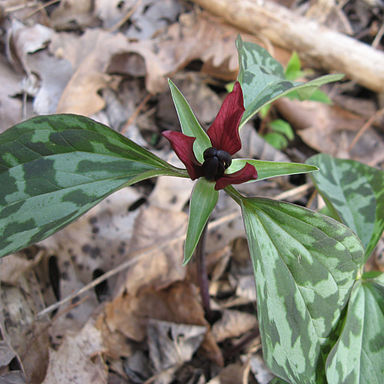Rhizomes horizontal, white, slender, elongated, brittle. Scapes typically 1(–3), round in cross section, 1.5–4.8 dm, slender to robust, glabrous. Bracts held well above ground, strongly petiolate; blade at first strongly mottled in darker green or bronze, mottling fading with seasonal expansion after anthesis, rarely all green, ovate, elliptic, or lanceolate, 6–18 × 2.5–6.5 cm, not glossy, apex acuminate; petiole ca. 1/5 bract length. Flower erect, fragrance not reported; sepals strongly recurved basally and held against scape by turgor pressure, green, sometimes purple-streaked, ovate-lanceolate, 18–35 × 6–18 mm, margins entire, apex acute; petals long-lasting, erect, ± connivent, ± concealing stamens and ovary, dark maroon purple to clear yellow, occasionally 2-colored with purple and yellow, not spirally twisted, lanceolate to ovate, 1.8–4.8 × 0.9–2 cm, thick-textured, base attenuate to weakly clawed, margins entire, apex acute; stamens incurved, 10–15 mm; filaments erect, dark purple, 4–6 mm, ± slender; anthers strongly incurved above filaments, dark purple, 5–16 mm, ± thick, dehiscence introrse; connectives strongly incurved inward, dark purple, projecting about 1 mm beyond anther sacs; ovary greenish with ± purple stains distally, transversely rhombic to angular-ovate, somewhat 6-angled or-winged, 7–10 mm, ± equaling filament height; stigmas erect, divergent-recurved, distinct, ± linear, 4–6 mm, slightly thickened basally. Fruits green to white-and purple-streaked, odorless, rhomboid-ovoid, 6-angled, almost winged, ca. 1 cm diam., pulpy. 2n = 10.
More
Rhizome horizontal, relatively long and slender; lvs with a distinct petiole 1–2 cm, the blade elliptic to ovate or subrotund, acute or short-acuminate, usually mottled; fl sessile; sep lance-triangular, commonly reflexed at anthesis, 2–2.5 cm; pet erect or arching inward, 2–3 cm, normally maroon, distinctly and slenderly clawed, the blade lanceolate to ovate, acute or short-acuminate; filaments half to fully as long as the distally incurved anther; stigmas slender, widely divergent, about as long as the 6-winged ovary; 2n=10. Moist woods; w. O. to s. Mich., s. Wis., and e. Io., s. to Ala., La., and e. Tex. Apr., May.


